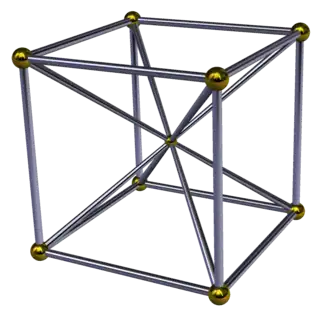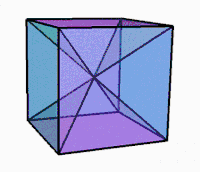| Cubic pyramid | ||
|---|---|---|
 Schlegel diagram | ||
| Type | Polyhedral pyramid | |
| Schläfli symbols | ( ) ∨ {4,3} ( ) ∨ [{4} × { }] ( ) ∨ [{ } × { } × { }] | |
| Cells | 7 | 1 {4,3} 6 ( ) ∨ {4} |
| Faces | 18 | 12 {3} 6 {4} |
| Edges | 20 | |
| Vertices | 9 | |
| Dual | Octahedral pyramid | |
| Symmetry group | B3, [4,3,1], order 48 [4,2,1], order 16 [2,2,1], order 8 | |
| Properties | convex, regular-faced | |
In 4-dimensional geometry, the cubic pyramid is bounded by one cube on the base and 6 square pyramid cells which meet at the apex. Since a cube has a circumradius divided by edge length less than one,[1] the square pyramids can be made with regular faces by computing the appropriate height.
Images
 3D projection while rotating |
Related polytopes and honeycombs
Exactly 8 regular cubic pyramids will fit together around a vertex in four-dimensional space (the apex of each pyramid). This construction yields a tesseract with 8 cubical bounding cells, surrounding a central vertex with 16 edge-length long radii. The tesseract tessellates 4-dimensional space as the tesseractic honeycomb. The 4-dimensional content of a unit-edge-length tesseract is 1, so the content of the regular cubic pyramid is 1/8.
The regular 24-cell has cubic pyramids around every vertex. Placing 8 cubic pyramids on the cubic bounding cells of a tesseract is Gosset's construction[2] of the 24-cell. Thus the 24-cell is constructed from exactly 16 cubic pyramids. The 24-cell tessellates 4-dimensional space as the 24-cell honeycomb.
The dual to the cubic pyramid is an octahedral pyramid, seen as an octahedral base, and 8 regular tetrahedra meeting at an apex.
A cubic pyramid of height zero can be seen as a cube divided into 6 square pyramids along with the center point. These square pyramid-filled cubes can tessellate three-dimensional space as a dual of the truncated cubic honeycomb, called a hexakis cubic honeycomb, or pyramidille.
References
- ↑ Klitzing, Richard. "3D convex uniform polyhedra o3o4x - cube". sqrt(3)/2 = 0.866025
- ↑ Coxeter, H.S.M. (1973). Regular Polytopes (Third ed.). New York: Dover. p. 150.
External links
- Olshevsky, George. "Pyramid". Glossary for Hyperspace. Archived from the original on 4 February 2007.
- Klitzing, Richard. "4D Segmentotopes". Klitzing, Richard. "Segmentotope cubpy, K-4.26".
- Richard Klitzing, Axial-Symmetrical Edge Facetings of Uniform Polyhedra
